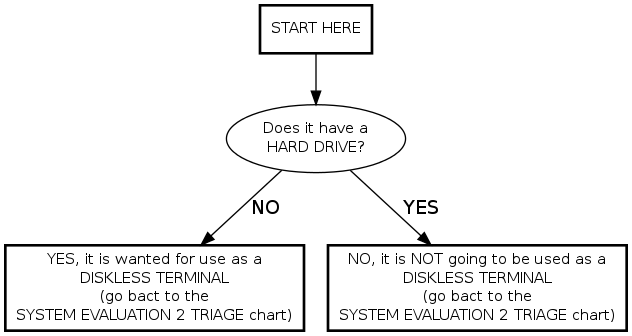Difference between revisions of "Diskless Terminal Triage"
Jump to navigation
Jump to search
(removed speed hdden) |
|||
| Line 14: | Line 14: | ||
diskless [label="YES, it is wanted for use as a\nDISKLESS TERMINAL", shape="box", fontsize="11", style="bold"] | diskless [label="YES, it is wanted for use as a\nDISKLESS TERMINAL", shape="box", fontsize="11", style="bold"] | ||
not [label="NO, it is NOT going to be used as a\nDISKLESS TERMINAL", shape="box", fontsize="11", style="bold"] | not [label="NO, it is NOT going to be used as a\nDISKLESS TERMINAL", shape="box", fontsize="11", style="bold"] | ||
| − | |||
start -> makemodel | start -> makemodel | ||
| Line 20: | Line 19: | ||
makemodel -> not [label="NO"] | makemodel -> not [label="NO"] | ||
formfactor -> not [label="TOWER"] | formfactor -> not [label="TOWER"] | ||
| − | formfactor -> | + | formfactor -> proc [label="DESKTOP"] |
| − | |||
| − | |||
proc -> speed [label="YES"] | proc -> speed [label="YES"] | ||
proc -> not [label="NO"] | proc -> not [label="NO"] | ||
Revision as of 23:23, 30 January 2006
NOTE: Diskless terminals will typically be used without their hard drives for computer labs. We only want certain makes and models, only desktop form factor machines, and only certain processor types and speeds. This means the low end diskless terms could be slower than the regular cutoff. Use this flow chart to help you determine if a system is slated to be a diskless terminal.
